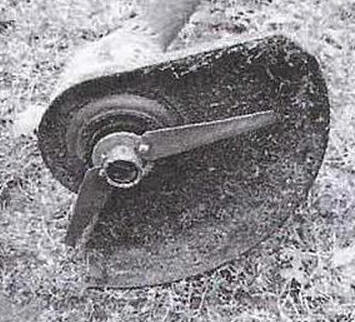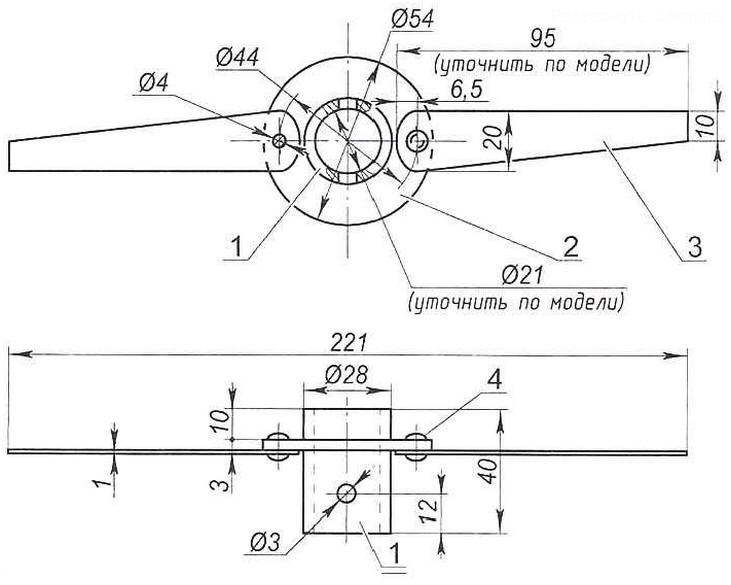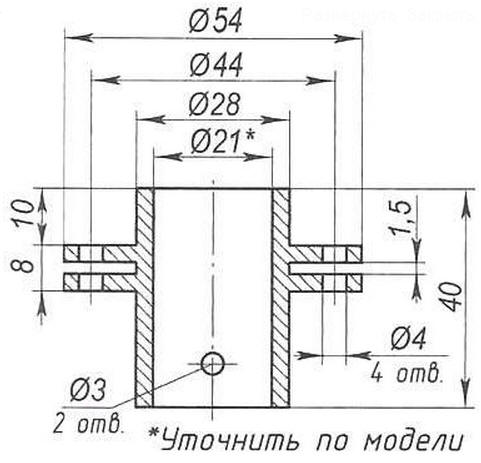 Free technical library
Free technical library
Mows a knife. Drawing, description

Directory / Tools and mechanisms for agriculture
 Comments on the article
Comments on the article
If you don't have a trimmer, your neighbor won't break it... So, to paraphrase a well-known song, you can start a story about problems with manual lawn electric mowers. Most models of imported electric trimmers (from the English word trim - trimming, haircut) are clearly not designed for mowing Russian near-house clearings, and even more so weeds near fences.
The very first foreign object caught in the grass leads to the failure of an important working part of the trimmer - the line reel. It was such a nuisance that happened to my friend Nikolai.
You can, of course, go shopping and buy analog Chinese spare parts (since original branded ones are expensive). But what's the point of spending money and time until the next rebar in the grass!
There is another way out of this situation - to think and find, so to speak, a "bypass" option.
"My neighbor somehow screwed a puck with thin stainless steel knife blades onto his "native" coil and now he is chopping everything with them!" - prompted a friend.
All clear! I have a tube, and a washer, and a stainless steel sheet ... But it will only look rougher.
"Not about aesthetics! The main thing is that the technique works!" - in the hearts, passionately, Nikolai explained the task to me.
To begin with, we turned on the trimmer and, substituting a hacksaw for metal to the remnants of the side walls of the coil, cut off everything superfluous. Now there is a plastic shaft to which something must be adapted.
The disc cutter worked, sawed a file, welding sparkled, a drill buzzed, a hammer riveted. At the end, the pliers unbent the antennae of the copper cotter pin.

The position of the knives in the free state

Modernized working attachment of a manual electric lawn mower with metal blades instead of fishing line (click to enlarge): 1 - shafting; 2 - working nozzle; 3 - protective cover; 4 - copper cotter pin
Some tricks:
- it is not easy to find suitable tubes for the sleeve, as well as a washer, therefore, to fit the tube along the shaft, it makes sense to cut a longitudinal strip of 2–4 mm from it, and then hammer it down to the desired diameter;
- the washer can be made with a chisel and a round file from sheet steel;
- it is enough to grab the washer to the tube by welding at 3 - 4 points on the docking circle;
- instead of steel rivets, use ordinary M4 screws;
- it is more convenient to drill holes for the cotter pin in place, after installing a new tool nozzle on the trimmer shaft.
The simplicity of the design made it possible to do everything in 30 minutes and conduct successful tests, first on the yard lawn, and then, by unwinding the coils of my own and another electric extension cord taken from a neighbor, and on the street, destroying weeds.

The position of the knives in working condition

The working part of the electric lawn mower (click to enlarge): 1-base sleeve; 2-washer (steel, sheet s3); 3 - knife (stainless steel, sheet s1, 2 pcs.); 4-steel rivets (M4 screw, 2 pcs.)

Turned steel base sleeve (more practical option) electric lawnmower
"Great! Just what you need! Doesn't mow, but shaves! Take a picture of the structure "for history" and it's time to go home, and tomorrow - for mowing!" - Nikolai summed up our meeting.
Such a design, of course, is much more efficient than the standard version with a cutting element made of fishing line, but it is also more dangerous. With such a trimmer, you should stay away from people, work in boots, and most importantly, avoid extreme wear of the petals and rivets.
Author: A.Matvejchuk
 We recommend interesting articles Section Tools and mechanisms for agriculture:
We recommend interesting articles Section Tools and mechanisms for agriculture:
▪ Lawn mower GK-1
▪ Motoblock Siberian
▪ microgrinder
 See other articles Section Tools and mechanisms for agriculture.
See other articles Section Tools and mechanisms for agriculture.
 Read and write useful comments on this article.
Read and write useful comments on this article.
<< Back
 Latest news of science and technology, new electronics:
Latest news of science and technology, new electronics:
Machine for thinning flowers in gardens
02.05.2024
In modern agriculture, technological progress is developing aimed at increasing the efficiency of plant care processes. The innovative Florix flower thinning machine was presented in Italy, designed to optimize the harvesting stage. This tool is equipped with mobile arms, allowing it to be easily adapted to the needs of the garden. The operator can adjust the speed of the thin wires by controlling them from the tractor cab using a joystick. This approach significantly increases the efficiency of the flower thinning process, providing the possibility of individual adjustment to the specific conditions of the garden, as well as the variety and type of fruit grown in it. After testing the Florix machine for two years on various types of fruit, the results were very encouraging. Farmers such as Filiberto Montanari, who has used a Florix machine for several years, have reported a significant reduction in the time and labor required to thin flowers.
... >>
Advanced Infrared Microscope
02.05.2024
Microscopes play an important role in scientific research, allowing scientists to delve into structures and processes invisible to the eye. However, various microscopy methods have their limitations, and among them was the limitation of resolution when using the infrared range. But the latest achievements of Japanese researchers from the University of Tokyo open up new prospects for studying the microworld. Scientists from the University of Tokyo have unveiled a new microscope that will revolutionize the capabilities of infrared microscopy. This advanced instrument allows you to see the internal structures of living bacteria with amazing clarity on the nanometer scale. Typically, mid-infrared microscopes are limited by low resolution, but the latest development from Japanese researchers overcomes these limitations. According to scientists, the developed microscope allows creating images with a resolution of up to 120 nanometers, which is 30 times higher than the resolution of traditional microscopes. ... >>
Air trap for insects
01.05.2024
Agriculture is one of the key sectors of the economy, and pest control is an integral part of this process. A team of scientists from the Indian Council of Agricultural Research-Central Potato Research Institute (ICAR-CPRI), Shimla, has come up with an innovative solution to this problem - a wind-powered insect air trap. This device addresses the shortcomings of traditional pest control methods by providing real-time insect population data. The trap is powered entirely by wind energy, making it an environmentally friendly solution that requires no power. Its unique design allows monitoring of both harmful and beneficial insects, providing a complete overview of the population in any agricultural area. “By assessing target pests at the right time, we can take necessary measures to control both pests and diseases,” says Kapil ... >>
 Random news from the Archive Random news from the Archive laser catapult
27.10.2015
If the nanoparticle is under the action of a laser pulse, the ions and electrons contained in it will begin to oscillate strongly and an induced electromagnetic field will appear around the particle - the so-called near field. It was studied by a group of German physicists from Rostock, Berlin and Munich.
They irradiated a silicon dioxide nanoparticle with a laser with a light pulse duration of four femtoseconds. The nanoparticle diameter varied from 50 to 500 nm. As it turned out, the larger it is, the stronger the field around it, and this leads to interesting consequences. Thus, an electron located on the surface can accelerate, fly away quite far from the particle, return to it again, hit, and fly away like a ping-pong ball.
"The energy of the electrons and the direction of their movement is strictly related to the geometry of the near field, and it can be controlled by a laser," says Professor Thomas Fennel from the University of Rostock, who built a mathematical model of the phenomenon. In this way, it is possible to obtain a narrow directed beam of fast electrons, and, in the future, ions as well. In the second case, you need to create a composite: add ions of some other element to the silicon dioxide lattice. By slowing down the electron beam, it is possible to create an X-ray beam for accurate fluoroscopy, and the ion flow is useful for irradiating cancerous tumors.
In addition, knocked-out particles can be used to treat the surface of materials, creating the smallest reliefs on them far beyond the limit set by the laws of diffraction. Among the fantastic proposals is the use of laser-beaten electron beams to create computing systems. Their speed will be determined by the duration of the laser pulse, that is, femtoseconds - a hundred thousand times faster than the current ones.
|
 Other interesting news:
Other interesting news:
▪ Artificial blood
▪ Robot policeman
▪ Dogs, like people, can experience anxiety.
▪ Effect of anions on the solubility of polymers
▪ Electric car charges in 30 minutes
 News feed of science and technology, new electronics
News feed of science and technology, new electronics
 Interesting materials of the Free Technical Library:
Interesting materials of the Free Technical Library:
▪ section of the website Experiments in Physics. Selection of articles
▪ article Make us beautiful. Popular expression
▪ article Which object from Shakespeare's play has become half the size in Russian translation? Detailed answer
▪ article Bufel grass. Legends, cultivation, methods of application
▪ article Save energy. Encyclopedia of radio electronics and electrical engineering
▪ article Radio transmitter with a fixed frequency master oscillator. Encyclopedia of radio electronics and electrical engineering
 Leave your comment on this article:
Leave your comment on this article:
 All languages of this page
All languages of this page
Home page | Library | Articles | Website map | Site Reviews

www.diagram.com.ua
2000-2024







 Arabic
Arabic Bengali
Bengali Chinese
Chinese English
English French
French German
German Hebrew
Hebrew Hindi
Hindi Italian
Italian Japanese
Japanese Korean
Korean Malay
Malay Polish
Polish Portuguese
Portuguese Spanish
Spanish Turkish
Turkish Ukrainian
Ukrainian Vietnamese
Vietnamese






 See other articles Section
See other articles Section 